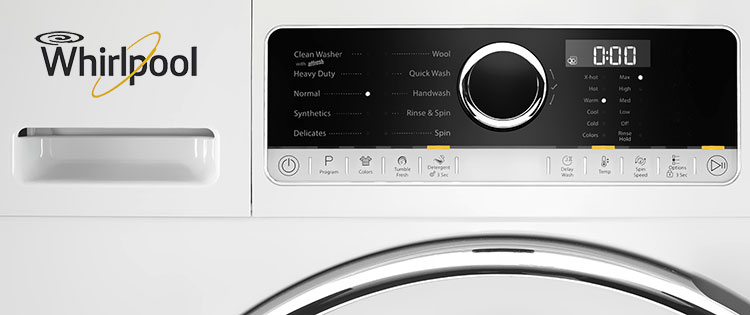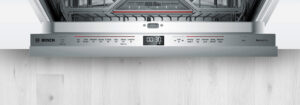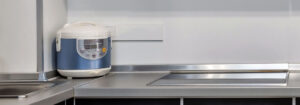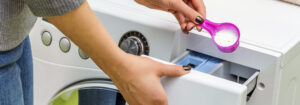Learning your Whirlpool washing machine error code messages
As the owner of a Whirlpool washing machine, you’re going to need to learn the error codes which are displayed to you. They help you to understand what’s exactly going on with your machine and provide you with an indication of what to do for the best. To make sure that you can appreciate all of the different error messages you’ll be getting, we at Just Fixed and have collected them all together in one place.

Codes 1 and 2: A09 or F01
These two codes are the first ones we’re going to be covering. Now, what you need to understand about these two messages is that they both mean the same thing. Regardless of which one of these messages you happen to encounter, they both give the same information; there’s no water detected in your washing machine.
There’s a couple of things you can do to fix the problem. First of all, you can make sure that both water supply valves are fully open and free from obstruction. Secondly, you can check for freezing inside the lines, but this tip is only useful in cold weather. Finally, you could consider bringing it to a professional like us.
Codes 3 and 4: A10 or F03
These two codes point towards a long time for draining the washing machine of any liquids inside it. If your washer doesn’t empty in the way you’d like, then it suggests you’re putting in too many suds or that there’s a blockage. You should, therefore, make sure you do something about the former and check for the latter. If you’re still struggling to resolve the issue, we’re always available.
Code 5: F02
The next error code which we’re going to be taking a look at is the error code F02. It means that there’s an overflow problem and can result in a flood if you’re not careful. When you get this kind of issue, the first thing you’re going to need to is to unplug the machine and prevent more water from getting into it. Then you’ll need to make sure that the water shutoff valve is working correctly and that all the sensors are in place. If they’re not, you might need to bring it to us.
Code 6: F05
Fault code F05 is what you’re going to experience when you find a failure with the temperature sensor. This can be, understandably, immensely annoying and so it is recommended that you take the time to try and fix it. This, for you at least, will involve checking all of the connections and making sure that they all behave healthily, and unsecured bonds should be fixed. If you’re not sure on what to do, then you need to come and ask us for help.
Code 7: F06
F06 is an error code which you’ll see when there’s a problem with the motor tachometer. The things you’ll need to do this can be difficult, so it’s okay if you aren’t up to the challenge. However, for those who feel like they can give it a go, you’ll need first to unplug the machine for safety’s sake. Then you’re going to need to make sure that you are checking the wire harness connections between the drive motor and the control board. You should reconnect any links which are loose. If this doesn’t resolve the problem, you may find that you need to replace the entire control board, which is where we would come in.
Code 8: F07
F07 only shows up when the motor can’t reach its required speed. This can sometimes be down to poor connections and in other instances is because technology is worn out.
Code 9: F13
F13 is where you get a door lock failure, and this often prevents the system from functioning at all. You need to make sure that you are checking for any obstructions in this instance, and that you’ve carefully looked for cracks or noticeable damage in the door itself.
Code 10: F14
F14 is a tricky one. It means that you’ve got an error with the primary electronic circuit board. Frequently, this involves waiting five minutes on a restart. If that doesn’t help, you’ll have to get a new board put in.
Code 11: F21
Now we’re moving into the ’20s and approaching the end of the list. An F21 error is what you’ll see when you’re experiencing a fault with the communication between the electronic and motor control boards. You should check for loose connections in the wiring, but you may need to get a part replaced.
Code 12: F22
F22 is an easy one to fix! It means that the system has detected a load of washing still inside the machine when it’s attempted to do a cleaning cycle, so you have to take it out and you’ll be good to go.
Code 13: F23
Code F23 is one to look out for when there’s a water level switch failure. It’s a major headache to deal with, and one you’ll naturally want resolving as soon as possible. You should unplug the machine and check to make sure that there’s no loose wiring to resolve, otherwise bring it into us.
Code 14: F24
We are approaching the last few codes! This message points to an overflow problem and means you need to cut the power to the machine and ascertain what exactly there’s too much of.
Code 15: F26
F26 is indicative of an error with the drive pump. It’s a tricky one and requires you to try and reconnect the loose wiring and check for signs of damage. If you can’t find any, you may have resolved the issue there and then.
Codes 16 and 17: F27 and F28
These two codes are telling you that there’s a motor control board problem. Once again, you’re going to find yourself unplugging the machine to check all the connections, and then replacing if needed.
Code 18: F29
F29 is a problem with the door. If your door looks like it’s stuck or obstructed by something, you’ll need to take steps to correct that right away.
Code 19: F30
We’re at the penultimate code! F30 is a problem with either the door OR the door lock. This distinction means that you may need a new lock or to test the current one to find out what the problem.
Code 20: Fod
Fod is the last code which you’ll come up against, and it means that you’ve got too many suds in the machine. Resolving this isn’t difficult, you need to make sure that you are using less in the way of detergent and watching what you put in the machine.
Overall, these are the different error codes which are available for you to learn. They all give you helpful advice, so don’t dismiss them out of hand! We at Just Fixed are always available to lend advice and perform repairs, but knowing what codes you’ve been seeing makes the process a little more streamlined. If you refer back to this guide when you encounter a new problem, then you should find that getting the most out of your machine becomes a pretty easy task.




